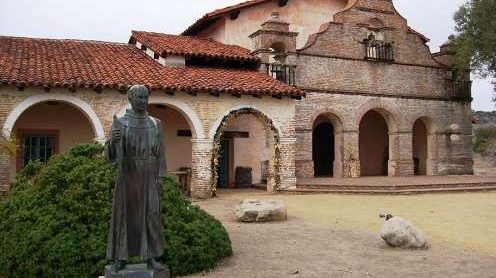A Catholic teacher who finished a pilgrimage to the Spanish Missions in California this week has emphasized his devotion to the first missions’ founder, St. Junípero Serra, and their influence on him as an educator.
Over the last two years, with a total of 45 days of walking, theology teacher Christian Clifford has trekked the California El Camino Real trail connecting all 21 missions. He finished the 781-mile pilgrimage June 22.
He told CNA that it has been an opportunity to walk in the shoes of the 18th-century friars, such as Serra, and to grow in virtues relevant to his experience as a teacher.
“I started visiting the missions and I really fell in love with them. I immerse[d] myself in learning more about it in the process. I [began] a real deep relationship with Junípero Serra,” he said.
“Those friars must have been very patient because they sacrificed a lot,” he added.
After he began teaching theology at Serra High School in San Mateo, he decided to learn more about the school’s patron and drove to the state’s 21 missions.
During this time, he authored three books about Spanish-Mexican history in California to help high school students understand the beautiful life of the missionary friars. One of the books, “Saint Junípero Serra: Making Sense of the History and Legacy,” tackles the controversial opinions of Serra, who is sometimes scrutinized by secular groups for his participation in Spanish colonialism.
“Saint Junípero Serra is such an amazing thing here. For those that don't know him, his life has been under a magnifying glass for a long time. We know so much about him … He can teach us so many things about being courageous evangelizers,” he said.
In May 2018, he began his pilgrimage on foot, starting at the northernmost mission in Sonoma, Mission San Francisco Solano, and made his way south to Petaluma in the North Bay. He said it was difficult, especially the first day, and even dangerous at times, as he had to walk along highways.
“I thought I prepared myself, got all my bag together,” he said. “By the time I reached my hotel, I thought I was going to die. My blisters were horrible, I had the wrong shoes. But, what happens is over time, you speak with other people and you learn new tricks. By the end of it, I was very comfortable, even in difficult situations,” he said.
A majority of the miles were covered last year, which marked the 75th anniversary of Serra High School and the 250th anniversary of the establishment of the first California mission in San Diego.
Clifford’s last portion was 138 miles from Mission San Fernando to Mission Santa Ines, in which he also visited Mission San Buenaventura and Mission Santa Barbara. He ended his journey marking the fifth anniversary of Serra’s canonization.
He said it has been a positive influence on his role as a teacher and a person, helping him grow in virtue and undergo similar experiences the friars went through. He said that during this year’s difficulties the pilgrimage helped him be patient with and understand students who were struggling.
“I think the thing that I learned the most is patience. So I try to be a more patient person with my students and my family life,” he said.
“I think in my life as a professional in particular, I need to be a little more patient with the young men that I teach, a little more understanding.”
He said the major goals of the pilgrimage were to draw attention to the holiness of Serra, and to raise awareness of the Mission San Antonio de Padua, which is struggling financially to meet earthquake codes required by the government.
“The Mission Saint Anthony of Padua is first of all, really cool, because it's the most isolated mission out of the 21, and it's located on a military base, but you don't need base access … You're literally walking back in time when you go there,” he said.
“I created a Go Fund Me … So overall [I raised] $1500, $1,600. But, I'm hoping that just by doing [the pilgrimage] more people go out there and visit it because it's so remote.”
He expressed the importance for Californians to understand the Catholic roots of the state, pointing to the significance of the names of cities, like San Francisco, Los Angeles, and San Diego. He said this rich history has meaning to not only the faith but practical arts like farming and ranching.
“The Catholic roots, all you have to do is look around right,” he said. “You can argue the El Camino Real path [is] probably based on Indian trails [and] it links to these major cities - San Francisco, the city of Saint Francis; San Jose, the city of Saint Joseph; Los Angeles, the city of angels … so these major population centers are all basically where the missions once were,” he said.

